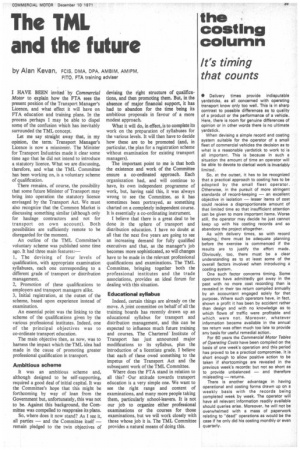The TML and the future
Page 41

If you've noticed an error in this article please click here to report it so we can fix it.
by Alan Kevan, FCIS, DMA, DPA, AMBIM, AMIPM, FITO, FTA training adviser I HAVE BEEN invited. by Commercial Motor to explain how the FTA sees the present position or the Transport Manager's Licence, and what effect it will have on FTA education and training plans. In the process perhaps I may be able to dispel some of the confusion which has inevitably surrounded the TML concept.
Let me say straight away that, in my opinion, the term. Transport Manager's Licence is now a misnomer. The Minister for Transport Industries made it clear some time ago that he did not intend to introduce a statutory licence. What we are discussing, therefore, and what the TML Committee has been working on, is a voluntary scheme of qualification.
There remains, of course, the possibility that some future Minister of Transport may bring into operation the statutory licence envisaged by the Transport Act. We must also recognize that the Common Market is discussing something similar (although only for haulage contractors and not for transport on own account). Both possibilities are sufficiently remote to be disregarded for the moment.
An outline of the TML Committee's voluntary scheme was published some time ago. It had three main features: 1, The devising of four levels of qualification, with appropriate examination syllabuses, each one corresponding to a different grade of transport or distribution management.
2, Promotion of these qualifications to employers and transport managers alike.
3, Initial registration, at the outset of the scheme, based upon experience instead of examination.
An essential point was the linking to the scheme of the qualifications given by the various professional institutes. Indeed, one of the principal objectives was to co-ordinate transport education, The main objective then, as now, was to harness the impact which the-TML idea had made in the cause of promoting greater professional qualification in transport.
Ambitious scheme It was an ambitious scheme and, although designed to be self-supporting, required a good deal of initial capital. It was the Committee's hope that this might be forthcoming by way of loan from the Government but, unfortunately, this was not to be. Against this background, the Committee was compelled to reappraise its plans.
So, where does it now stand? As I see it, all parties — and the Committee itself — remain pledged to the twin objectives of devising the right structure of qualifications, and then promoting them. But, in the absence of major financial support, it has had to abandon for the time being its ambitious proposals in favour of a more modest approach.
What it will do, in effect, is to complete its work on the preparation of syllabuses for the various levels. It will then have to decide how these are to be promoted (and, in particular, the plan for a registration scheme without examination for existing transport man agers).
The important point to me is that both the existence and work of the Committee ensure a co-ordinated approach. Each organiszation had, and will continue to have, its own independent programme of work, but, having said this, it was always wrong to see the Committee, as it has sometimes been portrayed, as something charted on a completely independent course. It is essentially a co-ordinating instrument.
I believe that there is a great deal to be done in the sphere of transport and distribution education. I have no doubt at all that the next five years are going to see an increasing demand for fully qualified executives and that, as the manager's job becomes more sophisticated, so will changes have to be made in the relevant professional qualifications and examinations. The TML Committee, bringing together both the professional institutes and the trade associations, provides an ideal forum for dealing with this situation.
Educational syllabus Indeed, certain things are already on the move. A joint committee on behalf of all the training boards has recently drawn up an educational syllabus for transport and distribution management, and this can be expected to influence much future training and courses. The Chartered ' Institute of Transport has just announced major modifications to its syllabus, plus the introduction of a licentiate grade. I believe that each of these owed something to the impetus of the Transport Act and the subsequent work of the TML Committee.
Where does the FTA stand in relation to all this? -Our attitude towards transport education is a very simple one. We want to see the right range and content of examinations, and many more people taking them, particularly school-leavers. It is not our job to organize either professional examinations or the courses for those examinations, but we will work closely with those whose job it is. The TML Committee provides a natural means of doing this.




































































































